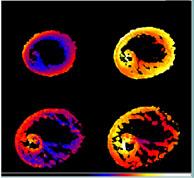


3.3.2. Model Velocity Fields
We conclude this section with some model velocity fields derived from hydrodynamic simulations by one of us (CSM). Tliese provide a small glimpse of the rich velocity structure one might expect to see in future high resolution kinematic studies of ring galaxies. Model velocity fields are presented in Figure 12 a-d at four different times after the off-center collision of a 1/5 mass companion with a disk. They show the radial velocity field of the model as viewed along the original spin-axis of the target galaxy. The model is similar to that described by Struck-Marcel) and Higdon (1993) and represents a model of the Cartwheel ring galaxy collision. A major effect in the velocity field is evident in Figure 12a, namely that a large radial velocity gradient dominates at this early time. This gradient is primarily due to the differential motion of the gas clouds in the vertical direction in the inner disk relative to the outer disk, an effect which appears to dominate the appearance of the velocity field when viewed along this special direction, close to the axis of rotation. This vertical "flapping" of the disk is an interesting 3-dimensional effect and is likely to complicate the interpretation of the ring expansion velocities when the ring galaxy is viewed from a different orientation. This effect may, in part, explain the large apparent expansion velocities in the Vela ring galaxy. Later in the evolution of the model (Figure 12b-d), when the second ring and spokes begin to form, the disk exhibits significant warping which is reflected in the gradient in the velocity field, superimposed on the other motions. Also interesting is the fact that the lowest velocities tend to be found near the geometrical center of the outer ring, rather than centered on the inner off-center ring and spoke. Unfortunately, the Cartwheel ring contains very little HI in the central regions and so little is known about the actual velocity field of any faintly emitting gas in this region. Finally, it is clear that quite sharp velocity features are seen radially across the ring at late times. This is a result of 3-dimensional structure in the ring which becomes more pronounced as the ring develops. Similar effects have been observed in the simulations of Gerber (1993). We caution that if low spatial resolution observations of gas motions were obtained, this complex velocity structure might be interpreted as vertical outflow of gas in the ring. On the other hand, real outflows are quite likely because of the vigorous star formation present in most rings. In conclusion, none of the above effects have yet been unambiguously observed in ring galaxies because of the lack of available high sensitivity, high resolution observations in neutral or molecular emission lines. It is clear that such studies, using either HI or CO emission as a probe, will ultimately provide one of the richest tests of the collisional model of ring galaxies. It is our hope that such comparisons will be made in the future.

|
Figure 12. (a-d) False color pictures of the velocity field of a model ring galaxy at various times after an off-center collision (see text). (See Color Plate VII at the back of this issue.) |